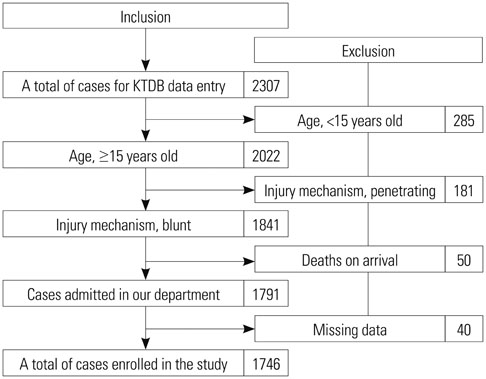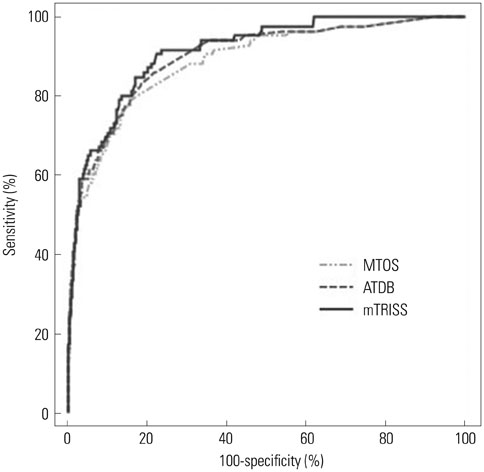Yonsei Med J.
2016 May;57(3):728-734. 10.3349/ymj.2016.57.3.728.
The Applicability of Trauma and Injury Severity Score for a Blunt Trauma Population in Korea and a Proposal of New Models Using Score Predictors
- Affiliations
-
- 1Division of Trauma Surgery, Department of Surgery, Ajou University School of Medicine, Suwon, Korea. jake98@daum.net
- 2Ajou Regional Trauma Center, Ajou University Hospital, Suwon, Korea.
- KMID: 2374094
- DOI: http://doi.org/10.3349/ymj.2016.57.3.728
Abstract
- PURPOSE
The purpose of this study was to verify the utility of existing Trauma and Injury Severity Score (TRISS) coefficients and to propose a new prediction model with a new set of TRISS coefficients or predictors.
MATERIALS AND METHODS
Of the blunt adult trauma patients who were admitted to our hospital in 2014, those eligible for Korea Trauma Data Bank entry were selected to collect the TRISS predictors. The study data were input into the TRISS formula to obtain "probability of survival" values, which were examined for consistency with actual patient survival status. For TRISS coefficients, Major Trauma Outcome Study-derived values revised in 1995 and National Trauma Data Bank-derived and National Sample Project-derived coefficients revised in 2009 were used. Additionally, using a logistic regression method, a new set of coefficients was derived from our medical center's database. Areas under the receiver operating characteristic (ROC) curve (AUC) for each prediction ability were obtained, and a pairwise comparison of ROC curves was performed.
RESULTS
In the statistical analysis, the AUCs (0.879-0.899) for predicting outcomes were lower than those of other countries. However, by adjusting the TRISS score using a continuous variable rather than a code for age, we were able to achieve higher AUCs [0.913 (95% confidence interval, 0.899 to 0.926)].
CONCLUSION
These results support further studies that will allow a more accurate prediction of prognosis for trauma patients. Furthermore, Korean TRISS coefficients or a new prediction model suited for Korea needs to be developed using a sufficiently sized sample.
Keyword
MeSH Terms
Figure
Cited by 1 articles
-
Inclusion of lactate level measured upon emergency room arrival in trauma outcome prediction models improves mortality prediction: a retrospective, single-center study
Jonghwan Moon, Kyungjin Hwang, Dukyong Yoon, Kyoungwon Jung
Acute Crit Care. 2020;35(2):102-109. doi: 10.4266/acc.2019.00780.
Reference
-
1. Boyd CR, Tolson MA, Copes WS. Evaluating trauma care: the TRISS method. Trauma Score and the Injury Severity Score. J Trauma. 1987; 27:370–378.2. Cayten CG, Stahl WM, Murphy JG, Agarwal N, Byrne DW. Limitations of the TRISS method for interhospital comparisons: a multihospital study. J Trauma. 1991; 31:471–481.3. Champion HR, Sacco WJ, Copes WS. Injury severity scoring again. J Trauma. 1995; 38:94–95.
Article4. Hannan EL, Mendeloff J, Farrell LS, Cayten CG, Murphy JG. Validation of TRISS and ASCOT using a non-MTOS trauma registry. J Trauma. 1995; 38:83–88.
Article5. Gabbe BJ, Cameron PA, Wolfe R. TRISS: does it get better than this? Acad Emerg Med. 2004; 11:181–186.
Article6. Demetriades D, Chan L, Velmanos GV, Sava J, Preston C, Gruzinski G, et al. TRISS methodology: an inappropriate tool for comparing outcomes between trauma centers. J Am Coll Surg. 2001; 193:250–254.
Article7. Glance LG, Osler T. Beyond the major trauma outcome study: benchmarking performance using a national contemporary, population-based trauma registry. J Trauma. 2001; 51:725–727.
Article8. Nakahara S, Ichikawa M, Kimura A. Simplified alternative to the TRISS method for resource-constrained settings. World J Surg. 2011; 35:512–519.
Article9. Deshmukh VU, Ketkar MN, Bharucha EK. Analysis of Trauma Outcome Using the TRISS Method at a Tertiary Care Centre in Pune. Indian J Surg. 2012; 74:440–444.
Article10. Chan CK, Yau KK, Cheung MT. Trauma survival prediction in Asian population: a modification of TRISS to improve accuracy. Emerg Med J. 2014; 31:126–133.
Article11. Kimura A, Chadbunchachai W, Nakahara S. Modification of the Trauma and Injury Severity Score (TRISS) method provides better survival prediction in Asian blunt trauma victims. World J Surg. 2012; 36:813–818.
Article12. Champion HR, Copes WS, Sacco WJ, Lawnick MM, Keast SL, Bain LW Jr, et al. The Major Trauma Outcome Study: establishing national norms for trauma care. J Trauma. 1990; 30:1356–1365.13. Schluter PJ, Nathens A, Neal ML, Goble S, Cameron CM, Davey TM, et al. Trauma and Injury Severity Score (TRISS) coefficients 2009 revision. J Trauma. 2010; 68:761–770.
Article14. Schluter PJ. Trauma and Injury Severity Score (TRISS): is it time for variable re-categorisations and re-characterisations? Injury. 2011; 42:83–89.
Article15. Schluter PJ. The Trauma and Injury Severity Score (TRISS) revised. Injury. 2011; 42:90–96.
Article16. Rogers FB, Osler T, Krasne M, Rogers A, Bradburn EH, Lee JC, et al. Has TRISS become an anachronism? A comparison of mortality between the National Trauma Data Bank and Major Trauma Outcome Study databases. J Trauma Acute Care Surg. 2012; 73:326–331.
Article17. Gunning AC, Leenen LP. Applicability of the predictors of the historical trauma score in the present Dutch trauma population: modelling the TRISS predictors. J Trauma Acute Care Surg. 2014; 77:614–619.
Article18. Wong GK, Teoh J, Yeung J, Chan E, Siu E, Woo P, et al. Outcomes of traumatic brain injury in Hong Kong: validation with the TRISS, CRASH, and IMPACT models. J Clin Neurosci. 2013; 20:1693–1696.
Article19. Brockamp T, Maegele M, Gaarder C, Goslings JC, Cohen MJ, Lefering R, et al. Comparison of the predictive performance of the BIG, TRISS, and PS09 score in an adult trauma population derived from multiple international trauma registries. Crit Care. 2013; 17:R134.
Article20. TRAUMA.ORG. accessed on 2016 January 1. Available at: http://www.trauma.org/index.php/main/article/387/.21. Sim J, Lee J, Lee JC, Heo Y, Wang H, Jung K. Risk factors for mortality of severe trauma based on 3 years’ data at a single Korean institution. Ann Surg Treat Res. 2015; 89:215–219.
Article
- Full Text Links
- Actions
-
Cited
- CITED
-
- Close
- Share
- Similar articles
-
- The practicality of interleukin-6 in prognosis of blunt chest trauma in Korea: a retrospective study
- Effect of Alcohol Consumption on the Severity of Blunt Injury
- Duodenal Injury after Blunt Abdominal Trauma: Report of Two Cases
- Renal Injury in Abdominal Trauma: Assessment of Incidence and Risk in the Admitted Patients
- Analysis of KTDB Registered Trauma Patients from a Single Trauma Center in Korea




